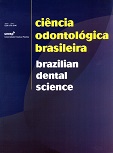Fatores relacionados ao diagnóstico tardio do câncer de boca no estado da Paraíba – Brasil: relatos de pacientes portadores
DOI:
https://doi.org/10.14295/bds.2009.v12i4.638Abstract
O Carcinoma Epidermoide (CE) da cavidade bucal, no Brasil, é uma patologia com incidência elevada, apresentando altas taxas de mortalidade e morbidade. O estágio da doença, no momento do diagnóstico caracteriza o mais importante fator de prognóstico. Neste estudo foram avaliados os fatores relacionados ao diagnóstico tardio desta patologia em pacientes no estado da Paraíba – Brasil, relatos e seu significado para estes pacientes. A amostra constou de 84 pacientes, diagnosticados no ambulatório do Serviço de Cabeça e Pescoço do Hospital Napoleão Laureano, em João Pessoa/PB. Foi realizada uma entrevista semi-estruturada com os portadores da doença, obtendo-se dados sócio-demográficos e as respostas que expressaram as razões da procura tardia do serviço de saúde. Identificou-se pela análise de conteúdo das respostas os significados do diagnóstico tardio e foram agrupados de acordo com seu conteúdo em: 1. Sabia da lesão, mas só procurou, quando incomodou; 2. Sabia da lesão, procurou um serviço de saúde e foi diagnosticado e tratado inadequadamente; 3. Não sabia da existência da lesão, procurou o serviço de saúde, quando incomodou; 4. Medo e negação da doença, temor do enfrentamento da doença; 5. Indisponibilidade de tempo por trabalho e dificuldade de acesso. Pela análise de conteúdo, o medo da doença, a desinformação e as condições sociais desfavoráveis representaram um desestímulo à procura do tratamento.
Downloads
Downloads
Published
How to Cite
Issue
Section
License
Brazilian Dental Science uses the Creative Commons (CC-BY 4.0) license, thus preserving the integrity of articles in an open access environment. The journal allows the author to retain publishing rights without restrictions.
=================




























